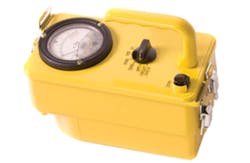Contaminant of the Month: Alpha Particles
What it is:
- Alpha particles (α) are high energy ionizing radiation emitted by some radioactive elements (e.g. radium-226).
- They are helium nuclei so they consist of two protons and two neutrons = 4 atomic mass units.
- They are energetic helium ions (He+2).
- They are much heavier and larger than the other two principal types of radiation, beta (β) and gamma (γ).
- Some common examples of radioactive elements that are alpha emitters include: Radium-226, uranium-238, plutonium-236, polonium-210 and radon-222. When a radioactive element emits an alpha particle it becomes an element with two fewer protons and two fewer neutrons (e.g., radium-226 becomes radon-222).
- Alpha particles are high-energy particles, but not radioactive in themselves. Because of their size and mass they have very limited penetration and they lose energy rapidly, even in air. Human skin or a piece of paper is sufficient to block alpha particles. Because they are cations they rapidly abstract electrons and become neutral helium gas.
Occurrence:
- Most alpha emitters are naturally occurring elements. The various natural radionuclides are generated spontaneously and occur in a decay chain.
- In the U-238 series, uranium-238 (half-life, 4.5 billion years) goes through several steps to become radium-226 (half-life, 1,602 years), which produces radon-222 (half-life 3.8 days), which becomes polonium-210 (half-life, 138 days), which ultimately becomes stable lead-206. So, it is possible to determine geological ages from the composition of the various radionuclides in the decay series and lead.
- The alpha emitters of greatest interest in drinking water are radium-226 and radon 222. They are groundwater contaminants widely distributed in the U.S. and associated with geological types.
- Radium is found around the country and commonly at higher levels in aquifers in the Midwestern states and in the South from Texas to Alabama and especially to South Carolina, then up the Eastern seaboard states. About 4 percent of samples exceed the MCL of 5 pCi/L.
- Radon is a noble gas and exposure is predominantly from inhalation of gas that has seeped into homes from their foundations and it is also present at low concentrations in ambient air.
- It is also widely occurring in groundwater associated with igneous rock with highest concentrations generally found in Western states from Montana to Arizona and along the Eastern seaboard form South Carolina to Maine. Some radon dissolved in groundwater will be transported into homes by drinking water, where it is released when taps are opened and during showering.
Analysis:
- The drinking water standards include a gross alpha screening and also radium-226, using EPA Method 900.0. The analyses are performed in specialized laboratories and not in typical water laboratories. The gross alpha test has complications for undercounting because it involves counting of a solid sample from the water. The release of the alpha particles for counting is impeded by the sample because of the low penetration of the alpha particles.
- Radon air sampling is accomplished by placing a collector in the room being tested. The half-life of radon is only 3.8 days. Collector kits are available from several sources. The accumulated radionuclides on the collector are analyzed and back calculated to the radon air concentration.
Health effects:
- Health risks from alpha emitters occur from the ingestion of the radionuclide and deposition in a sensitive tissue so that when the alpha particle release occurs it is very close to the target cell.
- Radium is chemically similar to calcium so it will deposit in bone — and bone cancer is a major risk.
- Radon is a gas so exposure is predominantly by inhalation. Lung cancer is the dominant risk. Between 14,000 and 20,000 out of about 160,000 deaths from lung cancer per year in the U.S. are estimated to be radon-related. Eighty to 90 percent of the deaths are smoking related.
Regulation:
- Gross alpha measurement is the screening technique used for regulation. It measures the alpha activity in the test sample. Gross beta is also measured in the test. The gross alpha MCL is 15 pCi/L. If the MCL is exceeded, speciation is required. The MCL for combined radium-226 and radium-228 is 5 pCi/L. Radium-228 is a beta emitter. The MCL for radon is 300 pCi/L. Natural uranium is weakly radioactive so it is regulated by its chemical toxicity to the kidney. The MCL is 30 µg/L.
Water treatment:
- Radium is chemically similar to calcium and magnesium so water softening by lime precipitation or cation exchange are excellent treatment techniques.
- Uranium usually exists as the uranyl anion so it is readily treated by activated alumina, iron oxides and anion exchange.
- Radon is a gas so if it is present at significant levels in groundwater it is treated by aeration.
- Granular carbon is also effective, but since the half-life of radon is only 3.8 days, radioactive decay products will accumulate on the GAC.
Dr. Cotruvo is president of Joseph Cotruvo and Associates, LLC, Water, Environment and Public Health Consultants. He is a former director of the U.S. EPA Drinking Water Standards Division.
